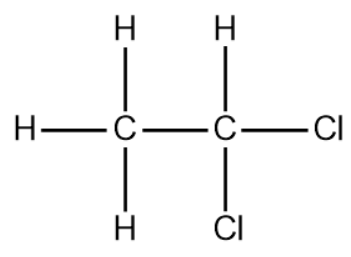
Gem dihalide on hydrolysis gives:
a.) vicinal diol
b.) geminal diol
c.) carbonyl compound
d.) carboxylic acid
Answer
510.3k+ views
Hint: Geminal dihalide hydrolysis is an organic reaction in which the gem-halide reacts with water or undergo hydrolysis in an alkaline medium. There are two products which can be formed.
Complete step by step solution: Geminal dihalides are dihalogen compounds in which both the halogen atoms are attached to the same carbon atom.
For example, Ethylidene dichloride

Suppose, there is a geminal dihalide
On hydrolysis, both of the chlorine group will be replaced by hydroxyl group (OH),
As both the hydroxyl groups are present on the same carbon, this compound is not stable. So, water acts as a leaving group i.e.
Thus, forming an aldehyde group
Now, let's take a compound
Similarly, as the previous example, this compound will also be unstable, thus water will act as a leaving group.
Thus, forming a keto or carbonyl group
Therefore, from the above statements we can conclude that the correct option is (c).
Note: Geminal dihalides are prepared by reacting a non-enolizable aldehyde and/or ketone with phosgene or thionyl chloride in the presence of an organic-phosphorus compound.
Complete step by step solution: Geminal dihalides are dihalogen compounds in which both the halogen atoms are attached to the same carbon atom.
For example, Ethylidene dichloride

Suppose, there is a geminal dihalide
On hydrolysis, both of the chlorine group will be replaced by hydroxyl group (OH),
As both the hydroxyl groups are present on the same carbon, this compound is not stable. So, water acts as a leaving group i.e.
Thus, forming an aldehyde group
Now, let's take a compound
Similarly, as the previous example, this compound will also be unstable, thus water will act as a leaving group.
Thus, forming a keto or carbonyl group
Therefore, from the above statements we can conclude that the correct option is (c).
Note: Geminal dihalides are prepared by reacting a non-enolizable aldehyde and/or ketone with phosgene or thionyl chloride in the presence of an organic-phosphorus compound.
Recently Updated Pages
Master Class 12 Business Studies: Engaging Questions & Answers for Success

Master Class 12 English: Engaging Questions & Answers for Success

Master Class 12 Social Science: Engaging Questions & Answers for Success

Master Class 12 Chemistry: Engaging Questions & Answers for Success

Class 12 Question and Answer - Your Ultimate Solutions Guide

Master Class 11 Economics: Engaging Questions & Answers for Success

Trending doubts
Draw a labelled sketch of the human eye class 12 physics CBSE

a Tabulate the differences in the characteristics of class 12 chemistry CBSE

Which one of the following is a true fish A Jellyfish class 12 biology CBSE

Why is the cell called the structural and functional class 12 biology CBSE

Differentiate between homogeneous and heterogeneous class 12 chemistry CBSE

Write the difference between solid liquid and gas class 12 chemistry CBSE




